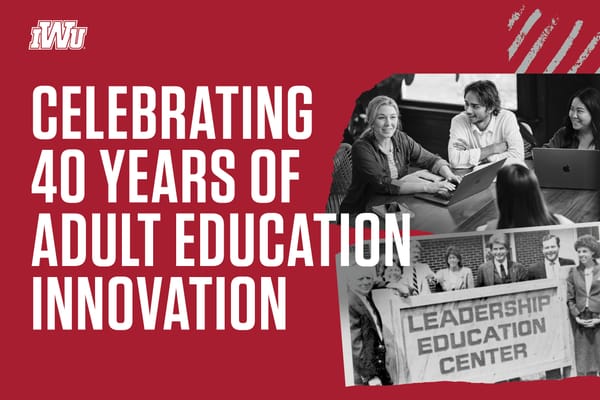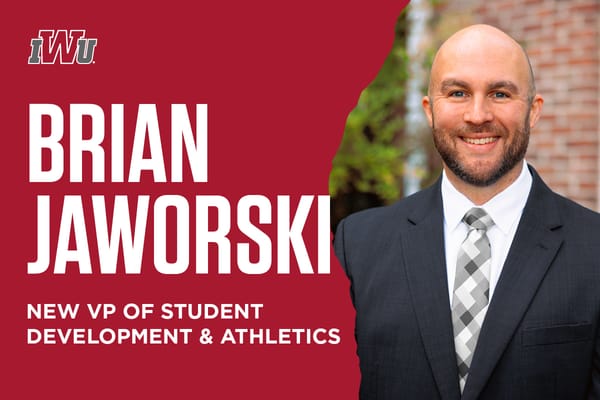Presidents of the Past—Robert R. Luckey (1976-1984, 1986-1987)

The Once and Acting President
Born the son of a previous acting Marion College president, Robert R. Luckey was connected to Marion College from the beginning. Growing up in Houghton, New York, Luckey later said he never remembered a time when he did not want to teach. For several years, Luckey lived and worked around the same university his father, James Luckey gave much of his life too. After gaining his Ph.D. in mathematics from Cornell University at an exceptional age, Robert Luckey began teaching analytical geometry at the age of 18.
Over the next several years, Robert and Ruth Luckey were married and had a son named Thomas. Just a few years prior to the Luckeys’ arrival at Marion College, Thomas Luckey passed away, leaving Robert and Ruth to deal with the grief, frustration, and confusion of watching as their child was taken from them at such a young age.
On January 17th, 1976, Luckey was chosen as the president-elect of Marion College by unanimous vote of the trustees, and on February 3rd, Luckey accepted. Luckey then visited campus for a week in early March to see the current state of the school and begin planning. Luckey was described as immediately displaying “an infectious spirit of optimism”. As soon as he arrived, it was clear Luckey cared about communicating with faculty, administration, and students—making these connections a priority to him even before he entered the presidency. During his visit, Luckey ate dinner with student leaders and listened to them explain the specific issues and concerns with campus which mattered to them.
During his first month as president of Marion College, Luckey established the school’s first full-time Alumni Director and in turn helped to establish alumni directories and everything else alumni related which the school now enjoys.
November 20th, 1976, marked the date of Luckey’s inauguration, held at College Church. The event was a resounding success—students, faculty, and staff all excited to see what the future held for the college. Like his predecessor before him, Luckey soon devised a plan which would determine the course of the next few years. Luckey’s three-year planned project would continue the long-range plans set in motion by Goodman during his administration, change the administrative team where needed but retain as much of it as possible, provide a new physical education center for the school—including refurbishing the Administration Building for the first time since its construction, and more.
Overall, the 1976-1977 academic year proved successful, and many elements of Luckey’s plan were already in the process of successful implementation. He was able to successfully raise $3,000,000 for renovations and construction, $2,200,000 of which was used to construct the new gym from scratch while the remaining $800,000 went to other expenses for the university. At the conclusion of this initial year, President Luckey discussed both the past year and his plans for the next with the editor of The Marion College Bulletin. When asked about what the biggest challenges of the year were in hindsight, he pointed toward the school’s need for a face-lift and the importance of establishing a stronger chain of command than what existed before.
President Luckey also worked with diligence to reach out to the Marion community and was essential in helping the college to build direct connections with the community, hosting a community tennis tournament on campus and becoming a member of the board of directors for the Marion Chamber of Commerce, as well as seeking qualified candidates for the Marion School Board when Indiana moved from appointed to elected school boards. Luckey also helped to establish two community advisory groups, one consisting of local business leaders and the other consisting of local women. All of his efforts became evident when the kick-off dinner for the gymnasium, held in September of 1977, drew in over a thousand people from the community.
Luckey very much hoped to help both Marion College and Marion itself develop stronger self-images, as he felt they were selling themselves short. If neither the city nor the school believed they were worthwhile places, then they never would be.
Regarding academics, Marion College added a Master’s in Ministerial Education program and a Master’s in Community Health Nursing. While the nursing department was still very young, it was already growing, accounting for 205 of the 860 enrolled students by this point in time.
The year 1978 proved a challenge for both Luckey and Marion College for multiple reasons beyond anyone’s control. On January 26th, a large blizzard hit Marion, with fifteen inches of snow recorded as well as 60 mph winds. This proved difficult for everyone in the city, creating struggles on campus for students, faculty, and staff—none of whom were able to attend to their duties and responsibilities in an effective manner during this time.
In March, an ongoing coal strike forced a 40% reduction in electricity consumption at Marion College, leading Luckey to send students home earlier than normal for an extended Easter vacation as the school was unable to function under these new restrictions. While the matter was resolved before the conclusion of the month, this issue still resulted in the school year going into May and requiring every class and event to re-organize. Students were forced to do more schoolwork with less time than ideal while professors were forced to cut pieces of the class which were included during any normal year.
The last blow of the year came that fall, when Marion College lost its accreditation through the NCA. While the school still received state accreditation, the amount of time and effort which was put into gaining NCA accreditation by both McConn and Goodman made the loss of it a major blow for both Luckey and the school. The fact it came at the conclusion of a year full of uncontrollable challenges just made it sting worse.
Despite all of this, enrollment was still reaching an all-time high, with 962 enrolled students, creating a brief housing crisis during which male students were forced to move into temporary housing until the conclusion of Williams Hall’s revitalization. Also of note, the 1980 commencement proved a historic occasion as the first ever graduation to feature graduate level students. Over the course of Luckey’s first four years, educational and general expenses increased by 68%, student expenses rose 47%, and financial aid increased by 50%. While the increased costs of everything were the result of the coal strike and blizzard creating issues, in large part, as well as the variety of construction projects going on, the amount was still more than ideal. The fact financial aid was still surpassing the rate at which student expenses increased, however, was at least good.
By 1981, enrollment passed 1,100 students, the physical education center reached completion, and a campus chaplain was hired. Noticing College Wesleyan Church and Marion College were both a great deal larger now than they once were, Luckey hired a retired Navy chaplain named Richard Bariess as the full-time chaplain for the college. Furthermore, recognizing the assistant dean of students, Dr. James Barnes, was excelling in his current role, Luckey planned to move him further up and make Barnes the head of continuing education—locating another individual who could fill Barnes’ current position as effectively as him became Luckey’s main concern.
In December, Luckey also embarked on a plan to construct a Christian Ministries Center, soon named for long-term Marion College community member Howard Noggle. Unfortunately, the location chosen for this building was the site of Century Hall. First constructed in 1865, Century Hall predated every college housed on the land over the past ninety years, even predating the administrative building. While both Noggle himself and the Christian Ministries Center were very well-liked, the move to demolish Century Hall was still one of the most controversial decisions of Luckey’s entire career.
By 1982, Luckey was responsible for tearing down twelve of the oldest building on campus to decrease the cluttered and claustrophobic nature the institution developed over the previous several decades through the construction of more and more buildings on the same limited amount of land. Even so, the campus was far from lacking in buildings. The four dorms were almost bursting with students—Shatford, Bowman, Teter, and Williams—and so too were the nineteen houses in use: Kempher, Wolfe, Easterday, Williams House, Baldwin, Ramsey, Rickey, Howell, Cartwright, Royal, Roberts, Downey, Duplex, Howlett, Harmony, Ott, Blanchard, Hullinger, and Howard. As a result, two additional apartments—Eastburn and Phillippe—were constructed to rectify this housing shortage.
When Luckey decided to retire after his second four-year term as president, the primary candidates for his successor were two of his closest advisors: Dean of the College Dr. James Barnes, and Director of Development Dr. James P. Hill. While Barnes was an alumnus of the university with many years of experience working in administration, Hill was three years into his time as an employee and was known for making highly positive impressions on people. The final decision regarding which would become Luckey’s successor was James P. Hill, but, after just two years, Hill departed.
Needing an acting president until a lasting replacement for Hill was found, Luckey stepped back into the role as acting president for the 1986-1987 school year. As a result of this, Luckey is the sole president in the history of the university to serve in the role at two separate times, this second presidency echoing his father’s role as a one-year-long acting president soon after the less-than-ideal departure of the previous one.
Hill’s tenure ending in an abrupt manner, right as it was beginning, created unease across campus which was made even worse when, on October 5th, a car accident resulted in the tragic passing of Joyce and Ellman Ott. Joyce was part of the Marion College family for twenty-eight years, starting in 1958 during McConn’s administration and spending many of her years as secretary to the president. As such, her sudden and tragic loss was not just the loss of someone who played an important role at the university—it was also the loss of a dear friend for each president she served under.
When Hill’s official replacement was named, few were surprised Dr. James Barnes was selected for the role, although the story of how Barnes would come into this position was less straightforward than most would expect. In his final letter within The Triangle (the recently combined alumni magazine and Marion College Bulletin), Luckey said, “In a real sense, this has been my mission this year–preparing the way for Marion’s new president, Dr. James Barnes. The trustees have selected a most capable young executive in Dr. Barnes. I enjoyed working with him as a colleague throughout my presidency, and now I am at ease as he assumes the leadership… Dr. Barnes will become one of Marion’s great presidents as we who love Marion College support him with our gifts and our prayers. May God bless him as he assumes his new role.”
During his original departure, the following achievements were noted of President Luckey, “Dr. Luckey’s foresight played a key role in working out an agreement with the City of Marion, leading to the building of the Aqua Dome—the first venture of its kind between a municipality and a private college. This same spirit of community awareness led to the development of the Colonial Oaks Retirement Center on a portion of the campus. Service to the Church continues as a prime concern, evidenced in the development of several new programs for preparing young people for service. Among these are nursing, computer science, social work, and masters in nursing and ministerial education. A faithful, loyal, and efficient wife, Ruth Luckey shares fully in her husband’s career. The Luckeys display genuine concern for people… a concern expressed in opening the President’s home to students needing temporary housing; hosting students, faculty, and staff on various occasions; complete involvement in community service; above all as clear Christian role models.”
By the time he left once more, the public image of Marion College had undergone significant change from where it was at the start of Luckey’s original time in office, over a decade prior. Given one of Luckey’s first goals was seeing the external and internal perceptions of Marion and Marion College change for the better, this was a clear success. Furthermore, speaking of Luckey, the Chairman of the Citizens Advisory Committee noted the “Christian philosophy he has expounded has touched the lives of all of the people in the Marion Community. His vision and guidance continue to be expressed daily by the people with whom he has surrounded himself” and calling him “a man who has earned the respect of this community and the esteem with which he is held.”
While this final year of Luckey’s time in office was unexpected, unplanned, and the result of unfortunate circumstances, it nonetheless served as a fitting encore to the career of a president who helped Marion College to grow, to connect, and to change in ways which—although difficult at times—consistently led to positive results.
Want to read more? Check out the other articles in the "President's of the Past" series!
- Henry C. Bedford (1919-1922)
- John W. Leedy (1922-1927)
- The Forgotten Presidents (1927-1932)
- William F. McConn (1932-1960)
- Woodrow I. Goodman (1960-1976)
- Robert R. Luckey (1976-1984, 1986-1987)
- James P. Hill Jr. (1984-1986)
- James B. Barnes (1987-2006)
- Henry L. Smith (2006-2013)
- David W. Wright (2013-2022)





